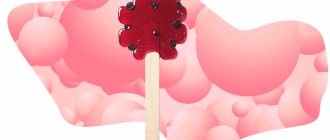The text is presented for informational purposes only. We strongly urge you not to self-medicate. When the first symptoms appear, consult a doctor. We recommend reading: “Why you can’t self-medicate?”
Scarlet fever is an acute childhood infection accompanied by intoxication syndrome, rash on the body, hyperemia of the pharynx and the symptom of a “raspberry” tongue. Most often, the pathology occurs in children aged 2 to 10 years. In adulthood, the disease can also occur when a number of certain conditions occur in parallel.
Causes of the disease
The causative agent of scarlet fever is β-hemolytic streptococcus of group A, which has a toxic (produces exotoxins), septic and allergic effect on the body.
Some strains of bacteria are highly aggressive. However, the occurrence of scarlet fever is determined not by etiology and epidemiology, but by the antitoxic immunity that the child has. Provided that at the time of infection with streptococcus there is no antitoxic immunity, scarlet fever develops. If it is present, there will be a clinic for tonsillitis, pharyngitis or another manifestation of streptococcal infection.
A typical patient with scarlet fever is a child in the age group from 2 to 9 years; a teenager rarely gets sick. The carriers of the infection are carriers of streptococcal strains or sick children with obvious or subtle (latent) forms of pathology. The sick person is a source of infection from the first day and for another two weeks after correction.
Newborns and one-year-old babies get sick very rarely, as they receive immunity from their mother. If the mother suffered scarlet fever in childhood, then the baby is protected and for the first six months of life nothing threatens him.
The highest incidence rates are recorded in settlements with cold and temperate climates. During the autumn and winter months, episodes of the disease are more common. The contagiousness rate is about 40%.
The spread of infection is favored by overcrowding of children and violation of sanitary and hygienic standards in kindergartens and schools. Streptococcus is very stable in the external environment and can survive for a long time in dust, on common objects, books, toys, and clothes.
More often, the microorganism causes the disease if the child has:
- lack of vitamins and microelements;
- weak immune system;
- foci of chronic infection (fungal, bacterial or viral);
- overwork, both mental and physical;
- frequent hypothermia;
- long-term use of certain medications (immunosuppressants, hormones, etc.);
- atopic allergy;
- sudden change in climatic conditions;
- constant stress;
- hormonal disorders;
- the presence of some systemic and local chronic diseases (pharyngitis, pathology of the adrenal glands, diabetes mellitus, tonsillitis, atopic dermatitis, etc.).
In recent years, there has been a trend towards a decrease in the incidence of scarlet fever. In 80% of patients the disease is mild.
After recovery, immunity to a certain serogroup of bacteria is developed and remains for life.
Therefore, scarlet fever can only be suffered once in a lifetime, but streptococcal infection can be contracted repeatedly.
Is it possible to get sick again?
Medical workers know cases of scarlet fever twice or even three times in a lifetime. The weakened immune system of the patient in combination with a number of provoking factors is to blame for this pathology. Such factors include untimely treatment of emerging scarlet fever, which is started too quickly in childhood, which can lead to stopping the mechanisms of formation of immunity against infection in the future. With early antibiotic therapy, antibodies produced in the body can be completely neutralized by drugs, which will lead in the future to a lack of immunity and the possibility of re-infection.
The second factor provoking recurrent disease may be infection at an early age. It is known that a child’s own immunity arises only by the age of 2, which means that he can become infected again with all the infections that he had previously suffered from. However, there are not many precedents for the infection of such young children in medical practice, since infants are usually protected by maternal antibodies from breast milk.
Another factor that provokes re-infection with scarlet fever may be simultaneous infection with several types of infection, which is also quite rare. Moreover, if the rubella and scarlet fever viruses enter the body at the same time, then an immune response occurs only in relation to the main, stronger one, and the second disease can be transferred again in the future.
Bacterial infections in modern conditions tend to develop resistance, so cases of re-infection with any infections to which a strong immunity must be formed in the human body cannot be excluded, therefore it is never worth neglecting methods of preventing such diseases.
Transmission routes
Common routes of transmission of the microbe are airborne and household contact. Less commonly, the infection can be transmitted:
- through products (food route of infection);
- in case of damage to the skin or mucous membranes (burn scarlet fever);
- airborne dust (transported with dust);
- due to iatrogenic reasons (non-sterile instruments, violation of aseptic and antiseptic rules);
- after childbirth (localization of the lesion on the inner surface of the uterus).
After being introduced into the child’s body, often by air through the mucous membrane of the tonsils and pharynx, the microorganism begins to multiply and release toxic substances. The establishment of the pathogen with the manifestation of the inflammatory process and local lymphadenitis was dubbed the primary scarlet fever complex.
The mechanism of pathogenesis consists in the development of the disease in three directions:
- toxic,
- allergic,
- septic.
Toxins affect the organs of the cardiovascular, endocrine and nervous systems.
Etiology
The main etiological cause of the infection is the penetration of pathogenic streptococci into the body, namely streptococcus pyogenes, which is a representative of serogroup A. Infection with scarlet fever occurs most often by airborne droplets, other routes of infection are much less common. However, the development of streptococcal disease may not occur in the presence of immunity and a strong immune system. It is the weakening of the immune system that is an important condition for the occurrence of scarlet fever.
Thus, entering the human body through airborne droplets, medical, household contact, sexual contact or through trauma to the skin, streptococcal bacteria against the background of a weakened body begin to infect it, provoking not only scarlet fever, but also other streptococcal infectious processes - tonsillitis, bronchitis, laryngitis, tracheitis, pharyngitis, meningitis, endocarditis. Among the factors that make the body of an adult or child more sensitive to the development of infections are hypothermia, vitamin deficiencies, improper work and rest schedules, chronic infectious diseases (sore throat, pneumonia, tuberculosis, diabetes), sedentary lifestyle, exposure to stress, bad habits. , drug abuse. In children under the age of 5-7 years, the immune system is not yet fully formed, which is the reason for the high likelihood of infectious processes occurring.
After a person has had scarlet fever, he or she develops immunity to scarlet fever. However, due to mutations in modern bacterial infections, it becomes possible to get scarlet fever a second time. That is why it is necessary to always remember the rules of disease prevention and not neglect them.
What does a sick child look like?
Signs of scarlet fever in children with the usual form of the disease will be expressed by a triad of symptoms:
- characteristic rash;
- angina;
- intoxication.
As a rule, parents observe a pinpoint rash all over the body in their child. Sometimes individual rashes look like small bubbles with liquid contents.
The skin is hyperemic and in its natural folds its color is dark red.
The eyes shine unnaturally, the face is bright, swollen, the throat is scarlet.
The tongue will be coated, then clear and become crimson with enlarged papillae (papillary symptom).
At the initial stage of the disease, the child will be excited, then lethargic. When the infection process subsides, peeling of the skin can be detected. The rash will gradually disappear, leaving no traces behind.
Scarlet fever can occur without a rash. Then its diagnosis is often accompanied by difficulties. This is why it is so important to see a doctor immediately if you have any signs of a streptococcal infection.
What are the first symptoms of scarlet fever that help make a diagnosis?
Simultaneously with sore throat and lymphadenitis, a small and abundant rash forms on the reddened skin, only the triangle between the nose and upper lip is free from it - it stands out as a white spot on the red face. The rash is tiny, no larger than a couple of millimeters, but the spots do not merge, although they are scattered very densely in the folds. The rashes are abundant on the sides and elbows, along the inner thighs and the back of the hands and feet. This is the most striking external sign of scarlet fever - exanthema. The rash may be accompanied by tiny hemorrhages and the same tiny blisters.
If you draw a fingernail across the skin, a white mark will remain for a long time, which is called “white dermographism.”
On the first day of the disease, the tongue is thickly coated with white, and after 3 days it is clear, but crimson in color due to the severity of the papillae; this symptom is called “crimson tongue.”
If symptoms of the disease occur, you must consult a doctor who is available seven days a week and on holidays at the Medicine 24/7 clinic.
Difference from other diseases
Differential diagnosis is carried out with pseudotuberculosis, yersiniosis, toxic-allergic conditions, measles, meningococcal infection, enteroviral exanthema, etc. Properties of some pathologies that distinguish them from scarlet fever:
- Measles . It has an initial period, a characteristic enanthema with Belsky-Filatov-Koplik spots in the mouth, a staged pattern of rashes and a tendency to unite them.
- Allergy . Skin manifestations have a cause and are varied in nature. The rash can look like spots, pimples, merge with each other, etc. Allergic reactions are often accompanied by a runny nose.
- Rubella . Elements of the rash are localized on the torso and extensor surfaces of the arms and legs; there is no acute tonsillitis.
- Mumps (mumps) . Inflammation first affects the upper respiratory tract and tonsils, then moves to the parasalivary glands. There is no rash.
- Whooping cough .
The main symptom is a prolonged, severe dry cough. Apart from this, the patient's general condition is normal. - Chickenpox . The rash with chickenpox in children is macular-vesicular, appears in waves, the palms and soles are never affected.
Streptococcal rashes are often differentiated from staphylococcal rashes. If the rash is caused by Staphylococcus aureus, there will definitely be a focus of purulent infection (felon, osteomyelitis, etc.).
Angina of another etiology may have various nonspecific symptoms. A thorough examination of the patient and laboratory diagnostics, including bacteriological analysis, help to recognize the diagnosis.
Often parents, having noticed this or that symptom, begin to panic and look for information on their own. They confuse the geographic tongue with the crimson color characteristic of scarlet fever, and mistake the common prickly heat for a rash. This “false scarlet fever” turns out to be a completely different disease.
Important! A doctor should always confirm or refute a diagnosis. Parents cannot, based on websites, study general material and photos, make medical conclusions about the condition of their child. A photo from the Internet cannot replace a professional inspection.
Which doctor treats scarlet fever in adults?
At the first symptoms of scarlet fever, you should visit an infectious disease specialist. Additionally, an adult patient should contact a local physician. If there are complications from the heart or upper respiratory tract, you may need to consult a cardiologist or otolaryngologist.
How does the disease progress?
The picture of the typical form of the disease is as follows:
First day
The disease begins suddenly.
Body temperature rises quickly, typical signs of intoxication appear: malaise, cephalalgia, nausea and vomiting, dry mucous membranes, thirst, muscle aches. There is rarely a cough, and even less often there is snot. The main complaint is intense pain in the throat, which gets worse when swallowing.
After several hours, a pink rash appears over the entire surface of the body in the form of small dots on the hyperemic background of the skin. On the face it has a specific character - it is located on the cheeks, without affecting the nasolabial triangle (Filatov’s symptom).
In the physiological folds of the skin and on the sides, the rashes are especially noticeable.
In the suprapubic region, in the groin, in the armpits, on the elbows, you can see dark red lines caused by a concentrated rash and a hemorrhagic component - Pastia's symptom.
Sometimes the elements of the rash appear as small blisters (1–2 mm) with clear or cloudy liquid. In severe forms, the rash becomes bluish in color. The skin is dry, rough to the touch, and bothers the baby, causing itching and pain.
When examining the oral cavity, the tongue is visible with a thick grayish coating, the pharynx is colored rich red, and there is swelling. A specific symptom is a sharp border of hyperemia - the tonsils, arches and uvula are affected, without spreading to the hard palate. Often there is a punctate enanthema, which can take on a hemorrhagic appearance.
Sore throat with scarlet fever can be catarrhal, follicular, lacunar, but necrotic is more common. Depending on the severity of the process, necrosis will be focal or widespread and have different depths of damage.
Grayish-green necrotic changes can affect not only the tonsils, but also neighboring structures.
Changes in the lymph nodes will depend on the degree of manifestation of angina. The lymph node increases in size, it is dense and painful. The lymph nodes in the anterior neck region react first.
On the part of the heart and blood vessels, the sympathicus phase is observed. It is manifested by rapid heartbeat and increased blood pressure. The influence of the tone of the sympathetic nervous system explains white dermographism (vascular response to tactile touch). Scarlet fever is characterized by increased permeability of small veins and arteries, which is detected using a tourniquet.
Second day
The main symptoms are increasing. The child's entire body is covered with a rash, including the palms and soles. The baby does not feel well, the body temperature will remain at the same level. The child may refuse to eat due to severe pain when swallowing, itch, or not sleep.
Fourth day
By the end of the fourth day, the rash gradually begins to fade. The temperature drops a little. The plaque on the tonsils partially disappears. The painful sensations pass. A characteristic feature of this period is a crimson tongue. It is clearly visible upon examination. The papillae on the tongue are enlarged, which is why it is popularly called strawberry papilla.
Sixth day
All symptoms are subsiding. The brightness of the tongue decreases, the tonsils become less red, and pain when swallowing gradually disappears. The rash disappears without a trace, being replaced by peeling skin. The parasympathetic tone (vagal phase) predominates.
There is a slow heart rate and hypotension.
Eighth–tenth day
The dynamics are positive. The skin begins to peel off throughout the body. The skin on your face will peel off in thin scales. On the body, neck and ears, peeling is pityriasis-like. Feet, palms, fingers and toes will be layered. First, the skin where the nail is cracks, then the changes cover the entire finger, then the palm. However, with a mild form of scarlet fever, the peeling is usually less pronounced. The symptoms of sore throat practically disappear. The thermometer shows normal numbers. The baby's health is improving.
Historical fact: the founder of Russian pediatrics, Nil Fedorovich Filatov, gave the nickname to scarlet fever - “flaming tonsillitis”, “fire in the pharynx”.
Is it contagious and how is it transmitted?
Scarlet fever is an exclusively infectious disease that can be contracted by contact or airborne droplets. Pathogenic streptococci, together with saliva or sputum, settle on various surfaces and are transmitted to other people. People who live with the patient are especially susceptible to the disease, because they share common household items.
If the symptoms of the pathology have gone away, it does not mean that a person can no longer infect others with scarlet fever. Microorganisms can remain in the patient’s body for several weeks after actual recovery. This means that the quarantine period should be slightly longer than the disease itself.
For an adult to get a streptococcal infection, two conditions must be met:
- Lack of specific immunity against streptococci. Everyone usually gets a group A streptococcal infection during childhood. But there are also those who avoided such a disease. They do not have specific antibodies, so infection is possible at any time.
- Weakened immunity. Pathogenic bacteria can only manifest themselves when the body is unable to resist them. Children have a weaker immune system than adults, so they are more susceptible to chickenpox, scarlet fever, measles, rubella, etc. Adults are susceptible to diseases only when their immunity is weakened.
Classification of the disease
Pediatrician Alexander Alekseevich Koltypin proposed classifying this pathology according to:
- like,
- heaviness,
- flow.
Forms of the disease that have symptoms characteristic of scarlet fever (rashes, sore throat, intoxication) are considered typical. Atypical ones include:
- erased light forms;
- extrabuccal types (post-burn, postpartum, etc.);
- severe forms (hypertoxic and hemorrhagic).
Mild forms of the disease occur without symptoms or with mild symptoms. With extrapharyngeal scarlet fever, when the primary focus is outside the oropharynx, there is no clinical manifestation of angina. The rash will predominate in the area where the infection enters. Regional lymphadenitis is also observed there. Characteristic signs of intoxication: fever and vomiting.
Severe forms can lead to death before a diagnosis is made and all the symptoms of the disease are revealed. That is why they got the name - engraved. They are not currently dating.
Typical scarlet fever in a child has the following forms:
- Easy . It is diagnosed in 80–90% of patients and has all the characteristic signs of the disease. Temperature 38–38.5°C, less often low-grade or normal. I'm worried about a headache, occasional vomiting, and feeling unwell. Sore throat is always catarrhal, lymphadenitis is mild. Exanthema is typical and goes away quickly. At the end of the week, clinical recovery is observed.
- Medium-heavy . Amounts to 10–20%. Fever reaches 39–40°C, signs of intoxication are evident. Repeated vomiting occurs. The child is excited, does not sleep, and may sometimes become delirious. Local manifestations have a clear clinical picture. Sore throat is accompanied by necrosis and effusion. Regional lymph nodes are sharply enlarged and may hurt. The acute stage lasts 5–7 days, full recovery occurs by 2–3 weeks.
- Heavy . It is observed extremely rarely (0.5% of cases). Has three types:
- toxic (temperature rise to 40°C and above, repeated vomiting, headaches, clouding of consciousness, meningeal and neurological symptoms, convulsions, sympathicoparesis, the rash is often hemorrhagic, has a bluish tint, catarrhal tonsillitis, sometimes with local necrosis);
- septic (local manifestations are very noticeable: deep necrotic changes in the tonsils and around them, the lymph nodes are large, dense and painful, with necrosis, the development of periadenitis and adenophlegmon is possible);
- toxicoseptic (combines general and local symptoms).
Important! Even with a mild degree, the disease can cause complications (purulent process, infectious heart, etc.). To minimize the risk of undesirable consequences, the child must be under medical supervision at all stages of the disease.
The course of the disease can be:
- smooth;
- unsmooth: allergic waves after scarlet fever, complications;
- abortive.
During a streptococcal infection, relapses are possible. This happens when meeting with another type of streptococcus. Reinfection or superinfection occurs.
Immune response to scarlet fever
The cause of an excessively strong immune reaction to the introduction of a bacterial agent, causing T-lymphocytes to release a shock portion of cytokines into the tissue, leading to severe intoxication with fever, pain, rash and gastrointestinal discomfort - bacterial superantigens.
The shell of the scarlet fever bacterium contains a special polysaccharide that stimulates an allergic response, causing an autoimmune reaction when the immune defense acts against its cells.
All these factors of bacterial resistance and increased penetration contribute to the development of pronounced clinical symptoms of the disease.
Only a qualified specialist with extensive diagnostic capabilities can quickly make a differential diagnosis and identify the cause of the pathological condition, and all this is possible at the Medicine 24/7 clinic.
If you have been diagnosed as a latent carrier of streptococcus, often have a sore throat or suffer from pustular skin diseases, contact a specialist at the Center for Infectious Diseases, call 24/7 +7 (495) 230-00-01
Possible complications
Complications that hemolytic streptococcus can cause are as follows:
- lymphadenitis;
- otitis;
- sinusitis;
- inflammation of the internal structures of the mastoid process of the temporal bone;
- arthritis;
- vasculitis;
- meningitis;
- inflammatory heart disease;
- kidney pathology;
- severe forms of allergies;
- erysipelas;
- phlegmon of the neck;
- pneumonia;
- rheumatic pathology;
- sepsis.
Complications of an inflammatory nature can manifest themselves in the early and late stages, after clinical recovery, and can be catarrhal or purulent.
The risk of their development is especially high in weakened children with immunodeficiency. However, even with timely treatment, purulent processes and relapses occur extremely rarely. After the invention of penicillin antibiotics, mortality from scarlet fever became almost zero.
Symptoms and forms of manifestation
Typical scarlet fever
The typical form of scarlet fever refers to the classic course of the disease with characteristic symptoms, which include rash, sore throat, crimson tongue, and fever. According to severity, typical scarlet fever is divided into mild, moderate and severe with toxic, septic and toxic-septic symptoms.
Also, typical scarlet fever can occur both without toxic-allergic reactions and with them in the form of synovitis, nephritis, reactive lymphadenitis. The pathology may have toxic-allergic processes, be complicated by purulent processes and septicopyemia, and be abortive.
Atypical form and its main manifestations
Atypical forms or erased forms of scarlet fever mean those pathologies that occur without the characteristic signs characteristic of this disease. Erased forms most often occur in adult patients; they are characterized by a mild and rapid course, without a long clinical course. In this case, the rash, if it occurs, is for a short time, the patients’ throat turns slightly red, sometimes patients notice slight nausea and low-grade body temperature. Erased forms may sometimes have hypertoxic or hemorrhagic aggravated symptoms.
However, with the toxic-septic form of atypical scarlet fever, the symptoms can be very severe. This is a rare phenomenon in medicine that occurs in adult patients with scarlet fever, and is accompanied by rapid development with a very high body temperature, the development of cardiovascular failure in the form of muffled heart sounds, threadlike pulse, a sharp decrease in blood pressure, and hemorrhages on the skin. Over the next day, these symptoms may be accompanied by infectious and allergic complications - damage to the heart, kidneys or joints, as well as septic complications in the form of otitis media, necrotizing tonsillitis, lymphadenitis and others.
There is also the concept of extrabuccal scarlet fever, when the disease occurs without any particular clinical manifestations and manifests itself only in a rash at the site of a violation of the integrity of the skin from a cut or burn, where the infection could penetrate.
Diagnostics
In the typical course of the disease, the diagnosis is made without difficulty, based on the clinical picture and examination. Atypical and erased forms may require additional examinations. The following methods help diagnose the disease:
- general blood test (an increase in ESR and neutrophilic leukocytosis with a slight shift to the left will be observed);
- isolation of beta-hemolytic streptococcus from swabs taken from the oropharynx;
- determination of the titer of streptococcal enzymes and antitoxins (antistreptolysin O, etc.);
- ECG;
- streptotest (a rapid test that detects the presence of group A beta-hemolytic streptococcus on the walls of the pharynx and tonsils);
- determination of the sensitivity of a microorganism to antibiotics (analysis is done in case of intolerance to penicillins, in case of ineffective therapy, etc.);
- Dick's reaction (0.1 ml of a standardized erythrogenic toxin is injected intradermally, an assessment is made a day later: if an infiltrate or redness with a diameter of more than 10 mm has formed at the injection site, the result is considered positive and means that antitoxic immunity will be absent).
If complications and concomitant pathologies are suspected, the doctor may prescribe additional diagnostic methods (ultrasound of the abdominal cavity and retroperitoneal space; determination of antibodies, biochemical blood test, general urine test, etc.).
What other diagnostic methods are used to detect scarlet fever?
A number of additional commercial rapid tests have been developed that detect streptococcal antibodies. Such diagnostics are performed directly at the patient’s bedside and in the clinic’s office in literally 5 minutes. The test is very accurate and not burdensome for the patient, the same smear with the mucous membrane, after which the swab is specially processed and the result is given.
The specific type of streptococcus - serogroup is determined using more complex modern methods of PCR, ELISA and others; there are special test systems for diagnosis. Their sensitivity can be affected by insufficient concentration of the microorganism, the use of antibiotics, as well as the duration of the immune response - antibodies appear after 10 days of illness.
At the Medicine 24/7 clinic, an individual approach is applied to each patient based on world diagnostic standards; all of our infectious disease specialists have been trained in the best medical centers, which allows us to identify the cause of the disease in a short time.
Treatment, nutrition and care
Hospitalization in a hospital is carried out according to clinical and epidemiological indications (patients are delivered by ambulance). Patients with mild to moderate forms of scarlet fever are treated at home.
When treating at home, it is necessary to create conditions that exclude interaction between the sick child and household members. It is necessary to disinfect the children's room (quartzing, cleaning, etc.).
During the acute period, bed rest is observed (usually duration is 8–10 days), during which you cannot go outside. Swimming is allowed at normal temperature and there are no contraindications.
The diet should be complete and gentle, with the exclusion of all irritating foods. The food is served warm and minced. Pediatricians recommend table No. 2.
The drug treatment plan includes:
Antibiotics
- penicillin series (“Amoxicillin”, “Amoxiclav”, “Augmentin”, “Flemoklav Solutab”, “Flemoxin Solutab”);
According to indications (complications, penicillin intolerance, etc.), the doctor can prescribe drugs from these groups:
- cephalosporins (Zinnat, Suprax, Cephalexin, Ceftriaxone);
- macrolides (“Azithromycin” (“Sumamed”), “Vilprafen”, “Clarithromycin”, “Klacid”);
- sulfonamides (“Biseptol”);
Other means
- hyposensitizing agents (“Tavegil”, “Suprastin”, etc.);
- strengthening therapy (immunomodulators, vitamin-mineral complexes, etc.);
- drugs that restore intestinal microflora, since after a course of antimicrobial therapy, stools are usually disrupted and the child suffers from diarrhea;
- detoxification therapy (“Reopoliglyukin”, “Enterosgel”, etc.);
- drugs to bring down the temperature (Nurofen, paracetamol, etc.);
- sympathetic therapy, for example, for nausea and vomiting, Cerucal is prescribed.
Used for local treatment of sore throats
- rinse (“Tomicide”, “Miramistin”, furatsilin);
- absorbable tablets such as "Lizobakt";
- Lugol's solution to treat a sore throat;
- Ural Federal District.
The doctor must prescribe medications and determine the sequence of treatment measures, taking into account the patient’s age, the course of the disease, the presence of complications and other factors.
The regimen and dosage of drugs is selected individually. If the patient is a one-year-old baby, then at the pharmacy you can choose a medication that is convenient to take in the form of drops or suspension.
Important! Follow the instructions for medications carefully. If you have any questions, ask your doctor - he will explain how to properly carry out the treatment.
Here's what Dr. Komarovsky says about the features of treating scarlet fever in children:
How do you start treating scarlet fever if diagnosis takes too long?
The determining factor in diagnosing a disease is not so much the positive tests as the professionalism of the doctor who made the diagnosis based on an examination of the patient. Tests have an auxiliary confirmatory role. In case of an atypical course of the disease and lack of response to therapy, of course, bacteriological analysis can “say the last word.”
Treatment of the patient and prevention of scarlet fever in adults in contact with him begins immediately after the doctor’s visit, before receiving test results; upon completion of the examination, correction of treatment tactics is carried out.
Treatment with folk remedies
Popular folk methods include:
- 30% citric acid solution (gargle and gargle every 1–2 hours for 2 days in a row);
- valerian (give 1–2 grams of crushed roots 4 times a day);
- infusion of cedar twigs (drink during the day for 1 month, then the course will be repeated for prevention);
- Herbal decoctions can be gargled, smeared on the skin and taken orally (chamomile, sage, calendula and others).
Important! The pediatrician should determine the advisability of using alternative treatment.
Nutritional Features
The text is for informational purposes only. We strongly urge you not to use diets, resort to any therapeutic menus or fasting without medical supervision. We recommend reading: “Why you can’t go on a diet on your own.”
In the case of scarlet fever, dietary nutrition is an important component of the entire treatment. At the same time, you should not overuse fatty and fried, spicy and smoked foods, since the body is already weakened from infection. It is necessary to exclude soda, coffee, chocolate, and other foods that irritate the mucous membrane of the pharynx from the diet.
Best materials of the month
- Coronaviruses: SARS-CoV-2 (COVID-19)
- Antibiotics for the prevention and treatment of COVID-19: how effective are they?
- The most common "office" diseases
- Does vodka kill coronavirus?
- How to stay alive on our roads?
You need to eat light soups and broths, liquid porridges, fresh fruits and vegetables, which provide the body with the necessary vitamins and microelements. In general, in the case of scarlet fever, doctors most often recommend a dietary menu according to the established diets “Table No. 2” or “Table No. 13” in the early stages of the disease, and “Table No. 7” after 14 days from the onset of the disease. The most beneficial is considered to be split meals up to 7 times a day with steamed cooked dishes. Among the most useful foods that should be included in the diet of a patient with scarlet fever are radish, cabbage, pumpkin, beets with their anti-inflammatory effects, berries, fruits, tea with lemon, black currant to cleanse the body of toxins and toxins and increase its protective functions, rosehip decoction, juices and compotes to eliminate symptoms of dehydration of the body, steamed fish and meat dishes, fermented milk products that prevent the occurrence of dysbacteriosis when taking antibiotics, honey, fish oil, etc.
Prevention
Parents of a sick child are interested in questions: how to recognize the disease, how quickly it goes away, how long it is contagious and, most importantly, how to protect yourself from infection. Dr. Komarovsky, like most pediatricians, emphasize that the best protection is prevention.
There is no vaccination (vaccine) against this pathology. Preventive measures are aimed at early detection of children infected with streptococcal infection and their isolation. According to the order of the Ministry of Health, the list of anti-epidemic actions is as follows:
- sick people are quarantined for 7–10 days from the onset of clinical manifestations; those who have recovered from the disease are allowed into kindergartens and schools only on the 23rd day from the onset of the disease;
- all surrounding people who have had contact with a sick child are subject to a medical examination;
- Small children (up to 2nd grade) who have not had scarlet fever and who have had contact with someone who has had it are subject to isolation for 1 week;
- employees of children's institutions who have not previously been ill and are in contact with a sick child are allowed to work, but under medical supervision;
- workers who have had a streptococcal infection are transferred for 12 days to a place where they will not pose an epidemiological danger, before which they are on sick leave;
- current disinfection is carried out with a 0.5% chloramine solution, dishes and linen are heat treated (boiled);
- If scarlet fever is again confirmed in the outbreak, the quarantine is extended for another week.
Recommendations for individual prevention:
- protect the child from visiting preschool educational institutions during outbreaks of infection;
- provide the baby’s body with all the necessary vitamins and microelements (the baby receives nutrients from mother’s milk);
- observe the rules of personal hygiene and teach the child this;
- learn about epidemics of acute respiratory infections and during this period avoid places where many people gather;
- prevent hypothermia;
- ventilate houses more often and carry out wet cleaning;
- do not forget to check vacuum cleaners, air conditioners, etc. (dangerous microorganisms can live in them);
- prevent stress and overexertion in the child;
- use natural phytoncides (onions and garlic) in the cold season;
- carry out immunoprophylaxis by taking antiviral and restorative drugs (Imudon, etc.).
After any infectious diseases, a child always needs rehabilitation. A small body requires more energy and time to recover. During this period, the child should receive adequate nutrition and not experience stress. All foci of chronic infection must be treated promptly.
On a note! Leading a healthy lifestyle and teaching this to your children is one of the important stages in the prevention of many diseases, which will help protect yourself and your family. An annual medical examination is also required, which can be completed at the clinic at your place of residence.
How does scarlet fever spread?
The main route of infection is through the air with drops of the patient’s saliva, when a healthy person inhales an aerosol infected with the microorganism. An infected person scatters his saliva over a distance of up to one and a half meters. It is more suitable for streptococcus to enter the nose than to penetrate through the mucous membrane of the pharynx; local conditions are slightly more favorable for active and immediate reproduction.
The cause of infection can be contact with a person with scarlet fever, when the pest is “picked up” from the hands, although this is more typical for skin forms of infection. Streptococcus does not disdain to travel through the alimentary route, moving to a person with food contaminated by the patient’s secretions.
Not only the patient can cause an outbreak of scarlet fever and other streptococcal infections, there is such a form as long-term streptococcal carriage without symptoms of the disease. If a fifth of a work team has a hidden bacteria, then employees there will regularly get sick.
Answers to frequently asked questions
Is it possible to get sick again?
If you have developed antitoxic immunity, you cannot get scarlet fever twice. You can become infected with a streptococcal infection a second time and get tonsillitis, pharyngitis, or other pathology typical of streptococcus.
Is it possible to bathe a child when he is sick?
You can wash during illness, but not during an acute period and at normal body temperature. The water should be warm so as not to irritate damaged skin. For the same reason, you should rinse your child from a ladle, and not from the shower. It is forbidden to rub the skin with a washcloth or towel, or to steam the child in a bathhouse, so as not to provoke the occurrence of local complications.
Is it possible to walk while sick?
During the acute period of the disease, the little patient must remain in bed; when the disease begins to subside, he can walk outside if the baby is in good health. Contact with other people while walking is allowed only on the 22nd day from the onset of the disease.
Are scarlet fever bacteria dangerous for humans?
The causative agent of scarlet fever has adapted to live in warmth; the temperature of the human body is optimal for it, but even in a cup of tea it floats alive for half an hour, it will not die in dried pus, and it can be poisoned with an antiseptic for a quarter of an hour without success.
The reason for the phenomenal harmfulness is in the amazing adaptations that the scarlet fever bacterium has created during its parasitism in humans. Streptococcal infection is not limited to scarlet fever, but has almost four dozen clinical manifestations, due to a whole set of pathogenicity factors, it protects itself as a terminator, releasing enzymes and toxins.
The Medicine 24/7 clinic conducts round-the-clock examinations using high-precision equipment, which allows you to quickly make the correct diagnosis and immediately begin treatment for scarlet fever, this is possible on holidays and weekends.
Diet for scarlet fever
The food given to the child during the period of illness should be soft and gentle so as not to cause additional irritation of the mucous membranes. But at the same time it must carry a certain nutritional load. The diet of a child with scarlet fever should be:
- homogeneous;
- easy to swallow;
- predominantly dairy-vegetable;
- All food is served pureed and boiled and only warm.
Warm compotes, berry fruit drinks, and jelly are used as drinks. Lingonberries, cranberries, and rosehips are useful. They saturate the body with vitamins and help replenish energy balance.
The nature of the rash with scarlet fever
All these symptoms are very similar to a sore throat. But in contrast, by the end of the first day of illness, a profuse purple rash appears on the neck and upper body, which quickly (within 2 hours) spreads throughout the body.
It is best expressed on the lower part of the body, the flexor surface of the arms, and in the axillary areas. (see photo below). Here, in the natural folds of the skin, the rash is especially intense. Often the rashes are localized on the inner thighs and sides of the chest.
Some affected children may have a miliary rash. It consists of small, within 1 mm in diameter, bubbles filled with a turbid liquid. If you press on them or stretch the skin over it with your fingers, they quickly disappear. Then they appear again when released.
The rash tends to appear as dark red stripes on the body. On the stomach it is barely noticeable and has a pale pink color. On the elbow and inguinal folds, in the perineal area, in both boys and girls, the rash is pronounced.
The baby's skin is dry, somewhat reminiscent of sandpaper. If you run your palm over your chest, you can feel goosebumps, as if the child is frozen. This is nothing more than a papular rash, very characteristic of scarlet fever.
Changes in the skin on the face are peculiar: the rash is located on the temples, forehead and cheeks. The areas of the nose, upper lip and chin remain pale, without rashes. This creates a sharp contrast with the purple of the cheeks. The rash lasts for 4 days.
It does not disappear without a trace, but leaves behind peeling, the onset of which occurs in the second week of the disease: large-plate and pityriasis-like. After the rash disappears, stripes of pigmentation may remain on the body. This sign is called Pastia's sign. It is very pathognomonic for scarlet fever.
A characteristic sign of scarlet fever is a sharp contrast between red, brightly glowing cheeks and a pale nasolabial triangle (as in the photo).











